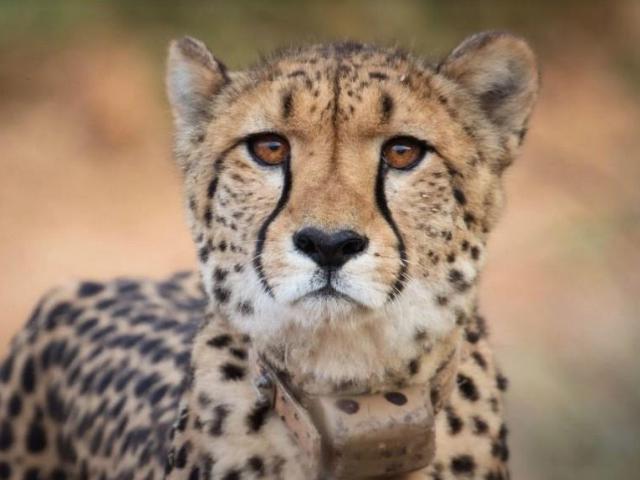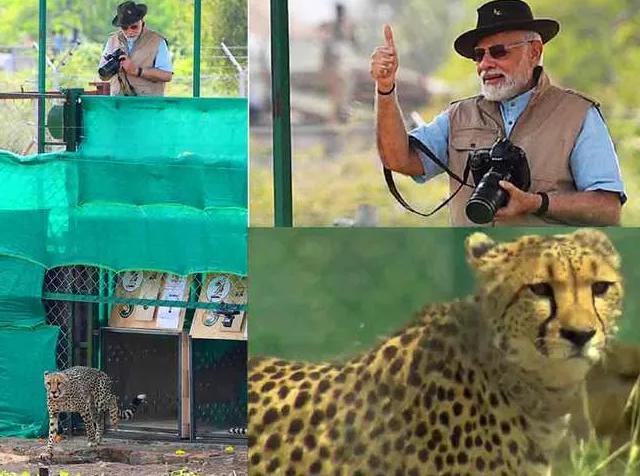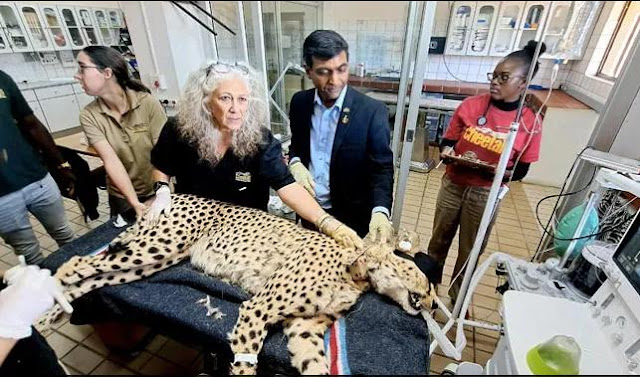The Story so far . The pleasant surprise of the birth of four cubs after the news of the death of the female cheetah Sasha in Kuno national park may have alleviated the pain; Sasha’s death has raised many questions. Amidst denial by cheetah conservation fund (CCF) that Sasha was unwell a year before she was brought to India, the question that is being asked is why she along with two more cheetahs was chosen when she was not suited for the wild. Leading Indian scientist and conservationist YV Jhala had already raised the issue of his objection through an email to the government before these animals were translocated to India.
Semi Wild Sasha Good For Soft Release, Not So for the Wild
Jhala was the architect of the project and author of the cheetah action plan and is the best brain to understand the issue .He coordinated at international level for the translocation of the iconic species. But almost immediately after the translocation of 8 Namibian cheetahs, he was first dropped from the expert committee constituted to monitor the step by step release of cheetahs in Kuno’s wilderness. Then his contract was truncated unexpectedly. After Sasha’s death, Jhala said, “the introduction programme is progressing in the right direction and achieved the goals”. Talking to thewildlifeindia , he explained “ the three animals which were released by the prime minister were born in the wild but were held in captivity for quite some time since a young age ... they were not the best animals to release back in the wild without proper training but they served the purpose of ( 1) genetic diversity ( 2) breeding females are difficult to obtain and these three females could form a breeding nucleus in an enclosed habitat patch from which we could then use the cubs to populate and supplement Kuno and other sites and (3) and semi-wild animal would tolerate the stress associated with the release by the PM much better than totally wild animals. “The release of the first cheetahs by the PM is a great bonus for the sustenance of the project. When the best or ideal animals are unavailable, the optimal management strategy is to bring the second best - that still serves project objectives and the project is better off with them than without them”, he said.
Also read: Namibian Cheetah Sasha Dies In Kuno National Park
But yes, he said, once they breed then their progeny would do well. For Mukundura ( the sanctuary of Rajasthan) , they ( the three females including Sasha) would have been fine as there are no tigers and very few leopards in the enclosure. He also said that the two of these semi-wild females mated, but unfortunately one died, due to a lifestyle issue of being in captivity for too long, and the other has now littered with 4 cubs. Jhala maintained that ,” that the action plan envisages a high rate of mortality amongst the founding cheetah, we are currently well below this estimated mortality and the project is poised for success with this litter of cubs and others on their way soon.”
Govt Says Sasha Was ill Before Brought to India, CCF Denies
When high mortality is expected in the project, then why so much is fuss over the death of Sasha. After her death, the government said that she already had a kidney infection a year before she was brought to India. Her creatinine level was 400 on August 15 2022, principal chief conservator of forest (wildlife) Madhya Pradesh JS Chouhan said, quoting her treatment history. Jhala said there was no infection caused renal failure but a lifestyle disease and most cheetahs in captivity suffer from this and almost 90% of cheetah deaths in captivity are caused due to this problem. The CCF Namibia has also sought to clarify through a tweet tagging a newspaper report where CCF was extensively quoted on Sasha’s ailment issue. It said, “ all the cheetahs sent to India for Project Cheetah underwent extensive health examinations , including ultrasounds ,blood draws and physical observations. They had to meet specific criteria ,including being wild born, clinically healthy and between 2.5 to 6 year old.” It also said, “Sasha had slightly elevated kidney values but no abnormalities were found”.
Also read: As You Watch The Elephant Whisperer, Let's Learn The Plight Of The Pachyderm
The CCF also dwelt in detail about the health care issues of cheetahs in general and those of Sasha in particular. Sasha might have been born in the wild, she was raised in captivity, a fact ignored conveniently by the CCF. Jhala also said that, “ I do not advocate blaming CCF for this - there was all possibility that Sasha would have lived and produced cubs just like Siyaya, there were no better cats available with CCF that the Namibian Government cleared for export to India; CCF does not own the cheetahs, the government of Namibia does.
After Kuno, Why No Mukundura
There are 19 cheetahs in Kuno, four of them in the open jungle. They include three males , one alliance of two brothers Freddie and Elton. All the 12 cheetahs brought from South Africa are still in quarantine in Kuno. After Kuno, according to the cheetah action plan, the government should have started looking for another cheetah home. For this, Mukundara hills national park in Rajasthan is already ready. With grass lands in between, this mountainous jungle has a variety of trees and animals. Though the state government has given green signal, the centre is not willing to shift cheetahs to Mukundura. Jhala said the three cheetahs which were considered as the second choice – it included Sasha also- would have been ideal for Mukundura. These animals would have flourished in this Rajasthan jungle, he said. The action plan also said that more cheetah populations are required to be developed. The idea was to develop 3 to 5 separate cheetah populations.
Also read: More Questions On Cheetah Project in Kuno
Jhala, the former dean of the Wildlife Institute of India said, “ As per the Cheetah Action Plan - Kuno by itself is not viable for the long-term as the site is not big enough to have viable population and for that you need atleast 3 population and then move cheetahs between them as a managed meta- population that is the vision of the cheetah project.” He said that the work has been slow in establishing other populations. The other jungles identified for the project cheetah were Gandhi Sagar sanctuary spread across Mandsaur, Neemuch ( both in MP) and Chittorgarh (Rajasthan) and Nauradehi sanctuary situated in Damoh and Sagar districts of Madhya Pradesh . But they need to be developed in terms of village rehabilitation, ecological and prey base restoration requiring Rs 300 crore to Rs 400 crore each. Mukundura is already ready. Putting all the 19 cheetahs in Kuno is like putting all the eggs in one basket.





Comments
Post a Comment